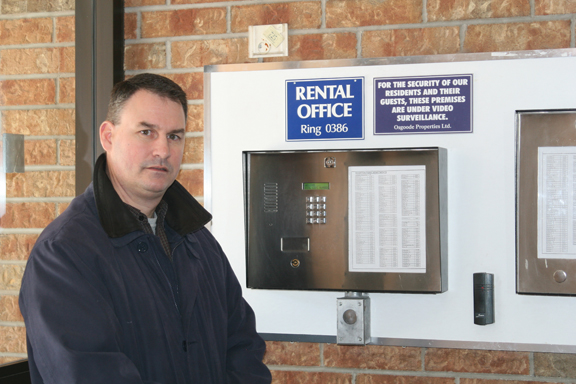
News
Residential property management firm chooses Brivo for access control
 Until recently, Osgoode Properties’ security system was a mish-mash of security software and systems with no central management or integration on a meaningful level.
Until recently, Osgoode Properties’ security system was a mish-mash of security software and systems with no central management or integration on a meaningful level.February 1, 2010 By Neil Sutton
 “The system we had before was essentially no system,” says Geoffrey Younghusband, residential portfolio manager.
“The system we had before was essentially no system,” says Geoffrey Younghusband, residential portfolio manager.
Ottawa-based Osgoode Properties, which operates 21 rental apartment buildings in Ottawa, Kingston and Gatineau, had been growing steadily through the 1990s into the mid-2000s, acquiring new buildings. As a result, Osgoode inherited a wide variety of incompatible security systems with no central management to speak of.
“We would have quite a variation of access systems,” says Younghusband. “Some would have registered keys, some wouldn’t, and you were rarely comfortable with who had what, and so on.”
Lack of good key management meant that tenants weren’t necessarily returning keys after they moved out or were making copies of keys and passing them along. As a result, Osgoode experienced security problems of growing severity.
“Maybe there was a fire started in the garbage chute. There would be graffiti on the wall of the building. Maybe they had apartment break-ins. Of course, you’re called to task on this. How are these people getting in?”
“Maybe there was a fire started in the garbage chute. There would be graffiti on the wall of the building. Maybe they had apartment break-ins. Of course, you’re called to task on this. How are these people getting in?”
A third-party management company called Briarlane, which takes care of Osgoode’s Toronto property, had solved its security problems through Double Vision Group Inc., a local security provider which had recommended and installed a Brivo access control system.
“In our dealings with them, we became aware of this company (Double Vision) and the (Brivo) system. We saw it working for them quite well in a property I would call ‘distressed.’ That was one of the pieces of the puzzle in order to stabilize the tenant profile and have the building start to perform better,” says Younghusband.
“I got a call from Geoffrey Younghusband to come up to Ottawa and take a look at the buildings and talk to him about some security,” says Carlo Di Leo, general manager, Double Vision, based in Richmond Hill, Ont. “We put together a plan for video and access control. The biggest need that he was looking for was to control all of his buildings.”
Due to the relatively large number of doors Osgoode has to manage (approximately 4,500 apartment units, plus front doors, locker rooms, laundry facilities, etc.), a simple software-based solution wouldn’t be able to handle the company’s needs. Di Leo recommended that Younghusband adopt Brivo’s ACS WebService — a hosted solution that could scale up to handle an increasing number of doors and could be managed centrally. ACS could also be upgraded remotely and automatically, minimizing the amount of maintenance required at the Osgoode end.
“Usually, with software-based systems, five years down the road when you’re adding more buildings on, they may be on version 5.0, whereas your first building is on 1.2. The benefit of the Brivo system is that it is constantly updated. They don’t have to worry about software updates on their system. As they add on buildings, it’s just integrated into the hosted system,” says Di Leo.
ACS WebService uses a tiered administration system with Younghusband as the master administrator, followed by property managers responsible for a group of buildings, and individual building managers. All three administration levels have different privileges and visibility on the system.
Younghusband began the upgrade with a few buildings — one that was experiencing a troubling amount of “delinquent activity,” another where the locks had to be rekeyed after the superintendent has disappeared with a master key, and a third, more expensive building, where upgraded security could be sold to tenants as a value-add.
To avoid future problems, like rekeying doors in the event of lost or stolen master keys, a keyfob system was installed. Keys can then be activated and deactivated centrally. If a tenant forgets to turn in a key after they move out, it can be deactivated remotely. Keyfobs can also be instructed to work on a timer. Laundry facilities, for example, are only supposed to be available between 8 a.m. and 8 p.m. With conventional keys, it’s a matter of relying on building managers to open and close laundry rooms at the correct hours. With the keyfob system, these doors are locked and unlocked automatically.
“The system just shuts the door out after that point,” says Younghusband. “So anybody who’s a resident can go into the laundry room between those hours. If you want to go in at 10 o’clock on a Saturday night, well then nobody can get in, regardless of whether you have the fob, because the system is telling the lock not to open.”
The system also lets Osgoode build a profile of when doors were opened and by whom. In the past, tenants have claimed that personal property was stolen from lockers. Prior to using the Brivo system, Osgoode was unable to substantiate or refute those claims. However, with the keyfobs in place, it’s easy to determine who the last person was to enter the locker room.
“We used to get a lot of complaints,” says Younghusband. “Sometimes they were real, sometimes they were frivolous, and sometimes they were exaggerated.”
Double Vision also installed a network of surveillance cameras that covered main doors, lobbies, stairwells and parking lots.
Print this page
Advertisement
Stories continue below
Related
Tags
- Special report: Transition to IP video has kept security market strong
- Ask the Expert: Four Factors to Consider When Selecting a Megapixel camera